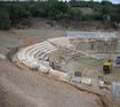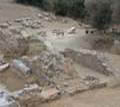
From the area comes a significant number of finds from the entire prehistoric era (ceramics, figurines and tools), from small-scale excavations.
At the site of Agios Georgios, acropolis of the late Bronze Age - early Iron Age (15th - 10th century BC), near Maroneia. Cyclopean walls 1330 m long, megalithic gates and the monumental building are reminiscent of the Mycenaean citadels of the southern mainland and the corresponding palace complexes. This is where the Homeric Ismaros or Ismara (pottery was found 9th - 8th century BC), city of the Thracian Kicones, as well as the sacred grove of Apollo. Maroneia was founded by Chios settlers at the beginning of the 7th century. BC, in the SW. slopes of Ismaru. From the acropolis, at the top of Agios Athanasios (height 678 m), two long walls with circular and rectangular towers descend to the sea (10.4 km long). From the ancient city are preserved: on the beach of Agios Charalambos a monumental apse propylon (Hadrian era, 124/5 AD ) that led to the market, the harbor (4th century BC), a large private house with two courtyards and a mosaic floor (3rd century BC), a sanctuary with a temple of Dionysos (4th century . BC), the well-preserved theater at Kampana site (with Hellenistic and Roman phase) and the marble quarries at Marmaritsa site. On a nearby hill, west of the Platanitis stream, there is a cave, which is related to the cave of the Cyclops Polyphemus. In the Paliochora site, within the walls, important early Christian finds: remains of a basilica with an atrium (beginning of the 6th century) adorned with a remarkable mosaic floor with the labors of Herakles, a bath of the period of Justinian I (527 - 565), remains of shops and storehouses, marble architectural members of churches and epitaphs. a large private house with two courtyards and a mosaic floor (3rd cent. BC), a sanctuary with a temple perhaps of Dionysus (4th cent. BC), the well-preserved theater at Campana site (with Hellenistic and Roman phase) and the marble quarries in Marmaritsa. On a nearby hill, west of the Platanitis stream, there is a cave, which is related to the cave of the Cyclops Polyphemus. In the Paliochora site, within the walls, important early Christian finds: remains of a basilica with an atrium (beginning of the 6th century) adorned with a remarkable mosaic floor with the labors of Herakles, a bath of the period of Justinian I (527 - 565), remains of shops and storehouses, marble architectural members of churches and epitaphs. a large private house with two courtyards and a mosaic floor (3rd cent. BC), a sanctuary with a temple perhaps of Dionysus (4th cent. BC), the well-preserved theater at Campana site (with Hellenistic and Roman phase) and the marble quarries in Marmaritsa. On a nearby hill, west of the Platanitis stream, there is a cave, which is related to the cave of the Cyclops Polyphemus. In the Paliochora site, within the walls, important early Christian finds: remains of a basilica with an atrium (beginning of the 6th century) adorned with a remarkable mosaic floor with the labors of Herakles, a bath of the period of Justinian I (527 - 565), remains of shops and storehouses, marble architectural members of churches and epitaphs. the well-preserved theater at Kampana site (with Hellenistic and Roman phase) and the marble quarries at Marmaritsa site. On a nearby hill, west of the Platanitis stream, there is a cave, which is related to the cave of the Cyclops Polyphemus. In the Paliochora site, within the walls, important early Christian finds: remains of a basilica with an atrium (beginning of the 6th century) adorned with a remarkable mosaic floor with the labors of Herakles, a bath of the period of Justinian I (527 - 565), remains of shops and storehouses, marble architectural members of churches and epitaphs. the well-preserved theater at Kampana site (with Hellenistic and Roman phase) and the marble quarries at Marmaritsa site. On a nearby hill, west of the Platanitis stream, there is a cave, which is related to the cave of the Cyclops Polyphemus. In the Paliochora site, within the walls, important early Christian finds: remains of a basilica with an atrium (beginning of the 6th century) adorned with a remarkable mosaic floor with the labors of Herakles, a bath of the period of Justinian I (527 - 565), remains of shops and storehouses, marble architectural members of churches and epitaphs.
Editor: Fotini Anastasopoulou



